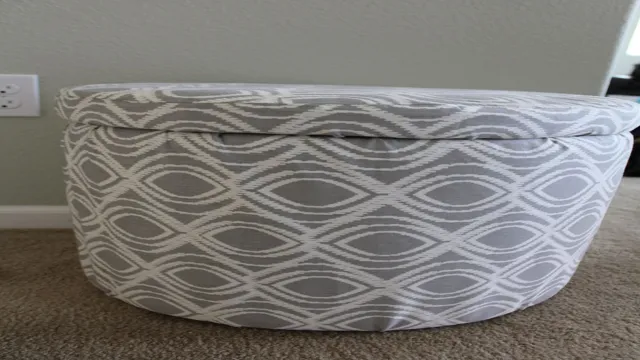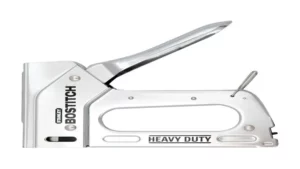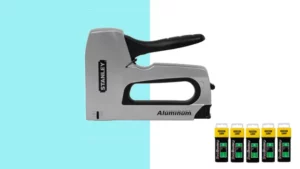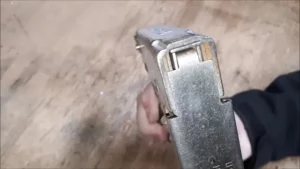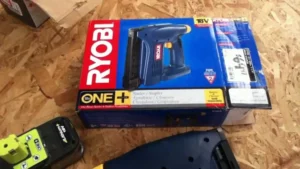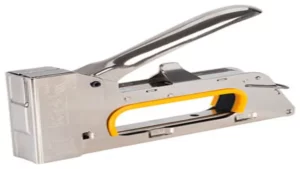Do you have an old round ottoman that’s seen better days? Before you toss it to the curb, consider giving it a new lease on life with a simple recovering project! All you need is some fresh upholstery fabric and a staple gun. Trust us, recovering a round ottoman is an easy DIY project that even beginners can tackle. Not only will it breathe new life into your tired piece of furniture, but it will also give you a sense of satisfaction that you created something new.
In this blog post, we’ll walk you through the steps of recovering a round ottoman using a staple gun – from choosing the right fabric to stapling it in place. So, grab your staple gun and let’s get started!
Gathering Materials
If you have an old round ottoman that needs a new look, you can easily recover it using a staple gun. But before you begin, you’ll need to gather some materials. Start by choosing your fabric.
Make sure it’s sturdy enough to withstand regular use and matches your décor. Next, you’ll need to measure the circumference and height of your ottoman to ensure you purchase enough fabric. You’ll also need a staple gun with staples, scissors, and a screwdriver.
It’s important to have a good staple gun, one with enough power to drive staples through the thick fabric. Once you’ve gathered all the necessary materials, you can begin the simple process of recovering your round ottoman.
Measuring Fabric
When it comes to measuring fabric, accuracy is key. Before you start any sewing project, it’s essential to gather all the necessary materials, including measuring tools such as a measuring tape or ruler. The first step is to identify the type of fabric you’ll be working with and select the appropriate measuring tool accordingly.
For example, if you’re working with a stretchy fabric, a flexible measuring tape will be ideal. On the other hand, if you’re working with a stiffer fabric like denim, a ruler might be a better option. It’s crucial to measure twice to ensure that you have the correct dimensions and avoid any errors in your calculations.
Remember, the success of your sewing project depends on your measurements, so take your time and be as precise as possible.
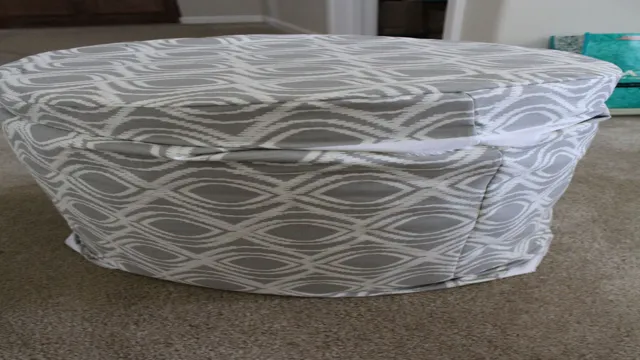
Choosing a Fabric Type
When it comes to choosing the right fabric for your project, you’ll want to keep in mind the specific qualities and characteristics you need for the finished product. Cotton is a popular choice for its softness and breathability, but may not be the best option for something that requires durability or moisture-wicking properties. On the other hand, polyester offers excellent durability and moisture-wicking abilities but may not be as comfortable to wear.
It’s important to consider the weight and texture of the fabric as well, as they can greatly affect the drape and overall look of the finished item. Take your time to research and compare different fabric types before making a decision, and always consider what will work best for your specific project.
Removing Old Fabric
When recovering a round ottoman, the first step is usually removing the old fabric. This can be a bit tricky, but with the right tools and techniques, it can be done smoothly and efficiently. One of the most important tools you’ll need is a staple gun, which will help you remove the old staples and fabric without causing any damage to the frame or foam padding.
To get started, locate the staples holding the old fabric in place, and gently remove them using a staple remover or flathead screwdriver. Once you’ve removed all the staples, carefully take off the old fabric, making sure not to tear or damage it. Once you’ve removed all the old fabric, you’re ready to get started on the next phase of your ottoman recovery project.
Don’t forget to keep the keyword “how to recover a round ottoman with a staple gun” in mind as you work your way through the process for best results.
Sanding and Painting the Frame (optional)
When it comes to sanding and painting a frame, the first step is to remove the old fabric. This is an optional step, but it can help to ensure a smooth and even finish on your frame. Start by using a pair of pliers to carefully remove any staples or tacks that are holding the fabric in place.
Once the fabric is removed, use a sanding block or sandpaper to smooth out any rough spots on the frame. Be sure to wear a mask to avoid breathing in any dust particles. Once the frame is smooth, wipe it down with a damp cloth to remove any dust or debris.
Now it’s time to apply a coat of primer to the frame to help the paint adhere. After the primer has dried, you can apply your paint of choice to the frame. Remember to apply several thin coats, rather than one thick coat, for a smooth and even finish.
With a little bit of time and effort, you can transform your old frame into a fresh and stylish piece.
Removing Old Staples and Fabric
Removing old fabric from furniture or other items can be a daunting task, but it is an essential part of the process when giving them a new look or repairing them. Before attempting to remove the old fabric, you should start by removing any old staples from the piece. You can use a flathead screwdriver to pry them out, or use a pair of pliers to grip and pull them out.
Be sure to avoid pulling too hard or twisting the staple out, as it can cause damage to the item’s underlying materials. Once the staples have been removed, you can move on to removing the old fabric. Usually, it’s held in place by the same staples you just removed but may have been glued as well.
In this case, use a utility knife to carefully cut away the glued areas, taking care not to damage the item. Work carefully and slowly, ensuring that you remove all of the old fabric, including any scraps or pieces left behind. By carefully following these steps, you can remove the old fabric from your project and get one step closer to giving it a new lease on life.
Cutting and Stapling New Fabric
If you’re looking to spruce up an old, tired-looking round ottoman, using a staple gun and some new fabric can make a world of difference. The first step is to measure your ottoman and cut a piece of fabric to the appropriate size, leaving enough extra material to fold over and staple to the bottom. Next, remove any old fabric that may be on the ottoman and use it as a guide to staple your new fabric in place.
Start on one side, pulling the fabric taut as you staple it down. Move around the ottoman, working your way from one side to the other, ensuring that the fabric remains smooth and wrinkle-free. Once you’ve stapled the fabric all the way around, trim away any excess fabric and you’re done! It’s a simple and cost-effective way to update the look of your ottoman and give it a fresh new feel.
Cutting the Fabric to Size
Cutting and stapling new fabric is a crucial task when it comes to sewing and upholstery projects. Firstly, before cutting, you need to ensure that your fabric is accurately measured to the required size. You can use a measuring tape or a marked cutting board to make sure your measurements are precise.
Once you have your measurements, you can carefully cut your new fabric using sharp scissors or a rotary cutter, making sure you follow the dimensions you need. Cutting fabric can be a bit daunting at first, but with practice, you’ll discover that it can be enjoyable in its meditative qualities. Once you have your pieces cut, you’ll need to staple them into place.
Make sure to use strong staples and a reliable staple gun to ensure your fabric stays in place for a long time. By doing this, you’ll ensure that your projects not only look great but will remain sturdy and usable for years to come.
Stapling the Fabric to the Ottoman
If you want to give your ottoman a fresh new look, cutting and stapling new fabric is a great way to do it. First, measure the dimensions of your ottoman and cut a piece of fabric that is slightly larger than those measurements. Lay the fabric over the ottoman and smooth it out, making sure it fits snugly and evenly.
Then, staple the fabric to the ottoman, starting in the center and working your way out towards the edges. Make sure to pull the fabric tight as you go to avoid any wrinkles or bunching. As you staple, be sure to check the alignment of the fabric to ensure it doesn’t shift or become crooked.
With a bit of patience and care, you can give your ottoman a whole new look that perfectly matches your decor.
Finishing Touches
Are you looking for a quick and easy way to give your round ottoman a new look? Using a staple gun is an efficient way to recover your ottoman while giving it a professional finish. First, remove the existing fabric from the ottoman and measure the dimensions of the new fabric you will need. Next, staple the fabric in place, starting at the center and working your way outwards, pulling the fabric taut as you go.
Make sure to staple along the edges of the ottoman and fold the fabric neatly on the corners to give it a clean finish. Lastly, trim any excess fabric and add any finishing details, such as decorative trim or buttons, to give your round ottoman a personalized touch. With this simple technique, you can easily update the look of your ottoman in no time, all while saving money on buying a new one.
A round ottoman with a staple gun is an affordable and creative way to refresh your living space.
Adding Decorative Trim (optional)
If you’re looking to add a special touch to your DIY project, consider adding decorative trim. Not only can it enhance the appearance of your project, but it can also hide any imperfections in your final product. There are many options for decorative trim, including rope, tassels, fringe, and lace.
The choices are endless and can help you achieve the specific look you’re going for. Adding decorative trim can be a simple and affordable way to elevate the overall appearance of your project. So if you’re looking for a finishing touch that will make your DIY project stand out, consider incorporating some decorative trim.
Trimming Excess Fabric
Trimming excess fabric is one of the most critical finishing touches in sewing and dressmaking. This process involves cutting off any extra material that isn’t needed or doesn’t add value to the garment’s overall design. When left unchecked, excess fabric can make garments appear bulky and unattractive, which undermines the entire sewing project’s aesthetic appeal.
Trimming is an essential step when finishing seams, especially if you’re working on projects that use thinner fabrics, such as silk or chiffon. By doing so, you’re not only ensuring clean lines and a smooth finish but also making the garment more comfortable to wear. So, if you want to achieve a professional-looking finish, don’t hesitate to invest the time and effort in trimming excess fabric.
Your sewing projects will look and feel better for it!
Replacing Ottoman Feet (optional)
If you’re looking to add a bit of character to your ottoman, replacing the feet might be just the finishing touch you need. Not only does it add a personalized look, but it can also help with functionality. For example, if you have hardwood floors, you might want to replace the feet with ones that have protective pads to prevent scratching.
Or, if you have a small space, you might want to add feet that are a bit taller to make it easier to clean underneath. When replacing the feet, make sure to measure the current ones to ensure you get the right size. You can find replacement feet online or at your local hardware store.
It’s a simple and easy way to give your ottoman a whole new look and feel.
Conclusion
In conclusion, recovering a round ottoman with a staple gun is like creating a work of art. Just like a painter who starts with a blank canvas, you begin with an empty ottoman. With a staple gun in your hand, you have the power to transform it into a masterpiece.
With a little patience, practice, and the right fabric, you can breathe new life into your old ottoman and give it a personal touch. And just like an artist’s inspiration can strike at any time, you never know when the urge to recover another ottoman may hit. So, grab your staple gun and unleash your creativity!”
FAQs
What materials are needed to recover a round ottoman with a staple gun?
To recover a round ottoman with a staple gun, you will need fabric, foam padding, a staple gun, staples, scissors, and a screwdriver (if your ottoman has legs that need to be removed).
Do I need to remove the old fabric before recovering my round ottoman?
Yes, it is recommended to remove the old fabric from your round ottoman before recovering it with a new one. This will ensure a smooth and even surface for the new fabric.
What type of fabric is best for recovering a round ottoman?
A durable and thick fabric such as upholstery or canvas is recommended for recovering a round ottoman. It is important to choose a fabric that can withstand daily wear and tear.
Can I recover a round ottoman without a staple gun?
While a staple gun is a recommended tool for recovering a round ottoman, it is possible to use a heavy-duty adhesive such as fabric glue or hot glue to attach the new fabric.
How do I ensure the fabric is tight and evenly stapled?
Start by stapling one side of the fabric to the ottoman, then stretch the opposite side of the fabric and staple it down. Repeat this process for the remaining sides, pulling the fabric tightly as you staple. Use a screwdriver to help tuck in excess fabric and create smooth corners.
Can I recover a round ottoman if it has tufted buttons?
Yes, it is possible to recover a round ottoman with tufted buttons. Simply cut small slits in the fabric where the buttons are, then use a needle and thread to reattach the buttons through the new fabric.
How do I reattach the legs to my round ottoman after recovering it?
Use a screwdriver to reattach the legs to the ottoman, making sure they are securely screwed in place. If necessary, you may need to drill new screw holes in the recovered ottoman.
